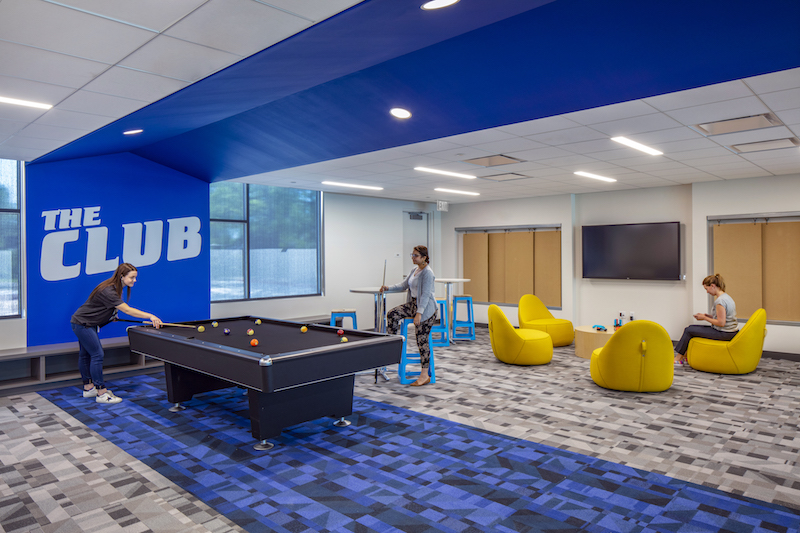The Boys & Girls Clubs of America annually serve 4.3 million young people annually, through membership and community outreach, in 4,300 Clubs across the country and BGCA-affiliated Youth Centers on U.S. military installations worldwide.
On April 26, the organization’s Austin, Texas, area club (BGCAA) held a grand opening for its 32,000-sf headquarters—known as its Home Club—on 10 acres in East Austin. The new facility will allow the organization to serve an additional 1,000 youth, and address challenges for economically disadvantaged local children who lack a place to go after school and during other out-of-school times.
More than 105,000 youth in the Austin market still lack free or affordable programming after school each day, according to the BGCAA, which prior to this opening was serving about 7,500 registered club members ages 6 through 18 years old at 36 locations in two counties.
The new two-story facility houses the BGCAA’s administrative offices, representing the first time in this market that those offices have been combined with the space for kids.

Children can get between floors by stairs or by sliding down a spiral ramp. Image: Tre Dunham
The site on which the club is located is called the Sheth Family Campus, so named in recognition of a multimillion donation made to BGCAA by Adria and Brian Sheth, founders of The Sheth Sangreal Foundation. The club’s indoor athletic facility is named in honor of St David’s Foundation, which donated $1 million.
An anonymous donor provided an additional $1 million, with numerous other significant donations from leading community and business leaders. Fourteen donors kicked in between $100,000 and $999,999 each.
The $14 million club, for which SpawGlass Contractors was the GC, includes a STEM learning center, library, art studios, teen center, and indoor-outdoor sports facilities. STG Design, an Austin-based architecture and design firm, provided the building’s interior design. STG donated a total of $250,000 worth of in-kind services throughout the duration of the project, which broke ground on April 17, 2018.
Themes of openness and honesty informed the design, whose exposed beams, open duct work and lighting grid serve as a teaching tool for showing children have things go together. The roofline is modeled after a traditional home so that building blends in with the surrounding community.
(The land the club now sits on was once zoned for single-family and light residential use, according to the Austin-American Stateman.)
Related Stories
| Jun 18, 2014
Arup uses 3D printing to fabricate one-of-a-kind structural steel components
The firm's research shows that 3D printing has the potential to reduce costs, cut waste, and slash the carbon footprint of the construction sector.
| Jun 16, 2014
6 U.S. cities at the forefront of innovation districts
A new Brookings Institution study records the emergence of “competitive places that are also cool spaces.”
| Jun 13, 2014
First look: BIG's spiraling museum for watchmaker Audemars Piguet
The glass-and-steel pavilion's spiral structure acts as a storytelling device for the company's history.
| Jun 12, 2014
Tod Williams Billie Tsien Architects' design selected for new UCSC facility
The planned site is a natural landscape among redwood trees with views over Monterey Bay, a site that the architects have called “one of the most beautiful they have ever worked on.”
| Jun 12, 2014
Austrian university develops 'inflatable' concrete dome method
Constructing a concrete dome is a costly process, but this may change soon. A team from the Vienna University of Technology has developed a method that allows concrete domes to form with the use of air and steel cables instead of expensive, timber supporting structures.
| Jun 11, 2014
David Adjaye’s housing project in Sugar Hill nears completion
A new development in New York's historic Sugar Hill district nears completion, designed to be an icon for the neighborhood's rich history.
| Jun 9, 2014
Green Building Initiative launches Green Globes for Sustainable Interiors program
The new program focuses exclusively on the sustainable design and construction of interior spaces in nonresidential buildings and can be pursued by both building owners and individual lessees of commercial spaces.
| Jun 4, 2014
Want to design a Guggenheim? Foundation launches open competition for proposed Helsinki museum
This is the first time the Guggenheim Foundation has sought a design through an open competition. Anonymous submissions for stage one of the competition are due September 10, 2014.
| Jun 4, 2014
Construction team named for Atlanta Braves ballpark
A joint venture between Barton Malow, Brasfield & Gorrie, Mortenson Construction, and New South Construction will build the Atlanta Braves ballpark, which is scheduled to open in early 2017. Check out the latest renderings of the plan.
| May 30, 2014
Riding high: L.A., Chicago working on their version of the High Line elevated park
Cities around the U.S. are taking notice of New York's highly popular High Line elevated park system. Both Chicago and Los Angeles are currently working on High Line-like projects.















